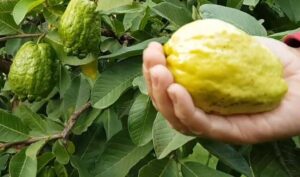This is a guide on how to prepare and use guava leaves with coconut oil for hair.
In brief: to use guava leaves with coconut oil for hair, just grind 20 fresh guava leaves in a mortar into a paste. Combine the paste with coconut oil and apply it on your hair. Leave the mixture on hair for one hour. Then, wash with a gentle cleanser and water.
Read on for step by step guide on how to use and prepare this mixture on your hair.

Overview
Hair bleaching and fall are very annoying. And additionally, even more, stressful is going to an expensive salon or buying products that sometimes come up with more harm than good.
All these struggles can make one come to the conclusion that healthy, lengthy, and shiny beautiful hair cannot be achieved until we go back to the natural home remedies.
Both coconut oil and guava leaves are proved to help hair growth. They are parked with essential oils and vitamins, minerals, and antioxidants that help promote hair health and regeneration.
You can learn more about guava leaves nutrients here and health benefits here
How to use guava leaves and coconut oil for Hair
Here is a step by step guide on how to prepare guava leaves and coconut oil:
Materials
- 20 fresh and green guava leaves
- 2 tablespoons of coconut oil
- Mortar and pestle
- Container
Method
Crush 20 fresh and green guava leaves into a paste using a mortar and pestle. Transfer the paste into a clean container.
Add to 2-3 tablespoons of coconut oil into the containing the guava leaves paste. Mix the coconut oil and guava leaves paste thoroughly. Cover the container and keep out of reach of children.
How to use guava leaves and coconut oil mixture for hair growth
Here is a step by step guide on how to use:
You need to wash your hair with clean water to free your hair from products. Air dry your hair. Then, gently cover your hair with this coconut oil and guava leaves mixture. Make sure the mixture is applied from tip to the root of your hair scalp.
Leave the coconut oil and guava leaves mixture on your hair for about 1 hour. After one hour, wash your hair with lukewarm water and gentle cleanser. Do this two to three times a week and stop when you feel satisfied.
Note: know that this mixture can also be used within 24 hours and after 24 hours you need to prepare another coconut oil and guava leaves mixture.
Benefits of coconut oil for hair
- Coconut oil serves as a conditioner for hair
- It helps nourish hair
- It can improve hair follicles regeneration
- It helps prevent hair from the effects of oxidative stress
- It is a strong anti-inflammatory and antimicrobial agent
- It helps moisturize hair and keep it shiny and beautiful
Benefits of guava leaves for hair
- Guava leaves help promote hair growth
- Guava leaves also help improve hair pigment
- The tea and paste of guava leaves are also good for preventing hair diseases such as dandruff and cancers.
You can learn more benefits of guava leaves for hair growth here:
Conclusion
In this article, we looked at the different ways in which you can prepare guava leaves and coconut oil mixture and use it for growing hair.
We hope the guide will be of excellent help for you on how to improve and grow your hair using natural additives. We will like to hear from you. So, do write to us in the comments section below.
Recommended Reading:
>Guava Leaves For Grey Hair: Benefits And How To Use
>How To Use Guava leaves For Black Hair
>Guava Leaves And Aloe Vera For Hair: Benefits + How-To Use
References
Patidar, Dr. (2018).; Preparation and evaluation of herbal hair growth promoting shampoo formulation containing Piper betle and Psidium guajava leaves extract. INTERNATIONAL JOURNAL OF GREEN PHARMACY. 12.
Díaz-de-Cerio E, Verardo V, Gómez-Caravaca AM, Fernández-Gutiérrez A, Segura-Carretero A. Health Effects of Psidium guajava L. Leaves: An Overview of the Last Decade. Int J Mol Sci. 2017;18(4):897. Published 2017 Apr 24.




